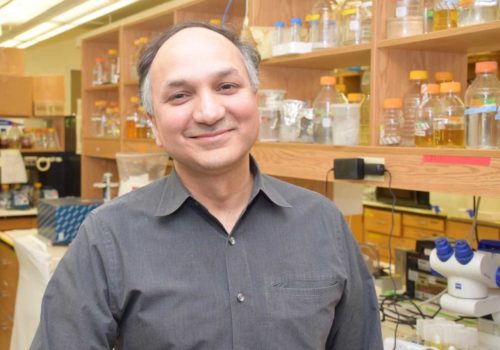
University of Guelph research rooted in traditional seeds and driven by contemporary science is helping plants produce their own all-important nitrogen. The findings could lead to a more sustainable way to provide crops with the nitrogen boost they need.
“A plant must have nitrogen to grow, but it can’t produce the essential element on its own,” said lead researcher Prof. Manish Raizada in the Department of Plant Agriculture. “This is why we feed agricultural crops nitrogen fertilizer.”
But the method of manufacturing nitrogen fertilizer is a major contributor of greenhouse gases, added Raizada.
Nitrogen fertilizers are manufactured through the burning of huge amounts of fossil fuel and about 50% of nitrogen fertilizer used on corn is wasted, either leaching into groundwater or turning into greenhouse gases, he said.
The research is focused on specific microbes in plants that are capable of converting nitrogen in the atmosphere into plant food. Infusing seeds with optimal nitrogen-producing microbes has the potential to significantly reduce or even replace the traditional method of manufacturing nitrogen fertilizer.
“When you breathe, 80 per cent of the gas you are actually breathing in is nitrogen,” Raizada said. “That nitrogen gas is in a form that plants and humans can’t use. It’s microbes that have to convert it into a usable form.”

Raizada’s team at U of G is feeding plants these beneficial microbes to help them manufacture nitrogen. They have identified that the best microbes for the job are those found in ancient Mexican and Central American varieties of corn seeds.
The researchers discovered that some varieties of so-called landrace corn – developed through selective breeding over thousands of years – thrive without the application of additional nitrogen.
The research goes back a few years, when Raizada and graduate student David Johnston Monje worked together to identify the microbes associated with plants that grew exceptionally well without a nitrogen boost.
“It turns out that there are some Indigenous peoples throughout Mexico and Central America, where corn originates, that report that they are able to grow corn without much nitrogen,” Raizada said. “We started a collaboration with CIMMYT, The International Maize and Wheat Improvement Center in Mexico, which holds the seed bank for the world’s corn seeds. David examined dozens of these corn seeds.”
A later graduate student, Hanan Shehata, discovered intriguing types of bacteria on seeds that were able to grow well without added nitrogen. She concluded that one microbe in particular was especially adept at producing nitrogen from the air and infusing it into plants. Her tests found that the presence of the microbe consistently boosted the size of rye grass – a relative of corn – by 50 to 100 per cent. Recent grad student Chris Dumigan found that other microbes also showed promise.
 “We knew we had a lot of good candidates and we knew that we had this really great candidate,” Raizada said.
“We knew we had a lot of good candidates and we knew that we had this really great candidate,” Raizada said.
Ultimately, he envisions a time when seeds coated with probiotic microbes and microbial sprays for soil could become commercial products.
The next step is to test their findings in wheat and grasses in the greenhouse. Cornfield trials in Canada and Colombia are also being planned.
One important question the researchers are interested in exploring is whether these microbes can make fertilizer on their own, without the need for a plant.
“The question we’re now asking is, why can’t we just put microbes in a bioreactor, feed them air and get them to make fertilizer? That is a long-term goal for us,” Raizada said.
Contact:
Prof. Manish Raizada
raizada@uoguelph.ca